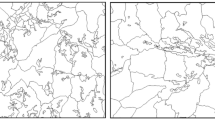Abstract
CITIES grow in a way that might be expected to resemble the growth of two-dimensional aggregates of particles, and this has led to recent attempts1á¤-3 to model urban growth using ideas from the statistical physics of clusters. In particular, the model of diffusion-limited aggregation4,5 (DLA) has been invoked to rationalize the apparently fractal nature of urban morphologies1. The DLA model predicts that there should exist only one large fractal cluster, which is almost perfectly screened from incoming ᤘdevelopment unitsᤙ (representing, for example, people, capital or resources), so that almost all of the cluster growth takes place at the tips of the clusterᤙs branches. Here we show that an alternative model, in which development units are correlated rather than being added to the cluster at random, is better able to reproduce the observed morphology of cities and the area distribution of sub-clusters (ᤘtowns') in an urban system, and can also describe urban growth dynamics. Our physical model, which corresponds to the correlated percolation model6á¤-8 in the presence of a density gradient9, is motivated by the fact that in urban areas development attracts further development. The model offers the possibility of predicting the global properties (such as scaling behaviour) of urban morphologies.
Similar content being viewed by others
References
Batty, M. & Longley, P. Fractal Cities (Academic, San Diego, 1994).
Benguigui, L. & Daoud, M. Geogr. Analy. 23, 362–368 (1991).
Benguigui, L. Physica A219, 13–26 (1995).
Witten, T. A. & Sander, L. M. Phys. Rev. Lett. 47, 1400–1403 (1981).
Vicsek, T. Fractal Growth Phenomena 2nd edn (World Scientific, Singapore. 1991).
Coniglio, A., Nappi, C., Russo, L. & Peruggi, F. J. Phys. A10, 205–209 (1977).
Makse, H. A., Hablin, S., Stanley, H. E. & Schwartz, M. Chaos, Solitons, and Factors 6, 295–303 (1995).
Prakash, S., Havlin, S., Schwartz, M. & Stanley, H. E. Phys. Rev. A46, R1724–R1727 (1992).
Sapoval, B., Rosso, M. & Gouyet, J.-F. J. Phys. Lett. 46, 149–152 (1985).
Clark, C. J. R. Statist. Soc. A114, 490–496 (1951).
Gouyet, J.-F. Physics and Fractal Structures (Springer, Berlin, 1995).
Bunde, A. & Havlin, S. (eds) Fractals and Disordered Systems 2nd edn (Springer, Berlin, 1996).
Frankhauser, P. La Fractalité des Structures Urbaines (Collection Villes, Anthropos. Paris, 1994).
Mills, E. S. & Tan, J. P. Urban Studies 17, 313–321 (1980).
Author information
Authors and Affiliations
Rights and permissions
About this article
Cite this article
Makse, H., Havlin, S. & Stanley, H. Modelling urban growth patterns. Nature 377, 608–612 (1995). https://doi.org/10.1038/377608a0
Received:
Accepted:
Issue Date:
DOI: https://doi.org/10.1038/377608a0
- Springer Nature Limited
This article is cited by
-
Computational Geometry-Based Kinematic Morphology for Urban Growth
Transportation in Developing Economies (2024)
-
Emergence of urban growth patterns from human mobility behavior
Nature Computational Science (2021)
-
Bridging human mobility and urban growth
Nature Computational Science (2021)
-
Projecting future populations of urban agglomerations around the world and through the 21st century
npj Urban Sustainability (2021)
-
Evaluating the contribution of urban ecosystem services in regulating thermal comfort
Spatial Information Research (2021)





